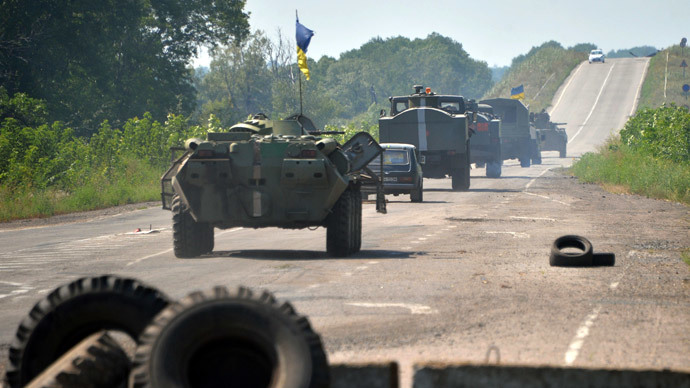EU ‘quietly’ lifts ban on supplying Kiev with weapons and technology – Russia

The European Union has “quietly” agreed to lift restrictions supplying Kiev with military technology and equipment which can be used for the “repression” in the country, the Russian Foreign Ministry said.
"During a recent meeting of the Council of Europe in Brussels, leaders of EU member states agreed 'on the quiet' to remove restrictions on exports to Kiev of equipment that could be used for internal repression," the ministry said in a statement on its website. "Exports of military technologies and equipment were also allowed."
Moscow slammed the move as "contradicting the rules of military technologies and ammunition exports which have been earlier applied by the EU" and also "pierced" by double standards.
‘Situation atrocious’: Russian Red Cross says E. Ukraine faces humanitarian catastrophe
The EU approved its rules for controlling the export of weapons and ammunition on December 8, 2008. Criterion #3 calls on the EU member countries to stop issuing export licenses for military equipment and technologies that can provoke or prolong conflict.

The decision to restart issuing licenses for special military equipment exports came despite the continuing “anti-terrorist operation” in eastern Ukraine, the ministry said.
“It is obvious why the EU is ignoring indisputable facts of shelling of Russian territory [in the southwest Russian region of Rostov] from the Ukrainian side: the perspective of feeling your own involvement in such actions creates certain discomfort in Brussels,” the statement said.
The ministry called upon its European counterparts “to follow logic,” not the "prodding" from Washington.
“The decision to limit the supply of ammunition and weaponry to Ukraine should have been introduced after the launch of the so-called ‘anti-terrorist operation’ in the Donbas and Lugansk Regions. It is not too late to restore the ban,” the ministry said.
Donbas, a historical, economic and cultural part of eastern Ukraine, includes the northern part of the Donetsk Region and the south of the Lugansk region.
Over 30 civilians killed during two days of shelling in Gorlovka, E. Ukraine (VIDEO)
The restrictions were introduced by the EU Council in February when Viktor Yanukovich was the country’s president and there was a severe confrontation between Maidan protesters and police.
“Then the EU decided that it was ‘wrong’ to supply ‘Yanukovich regime’ with weapons,” Moscow pointed out.
The restrictions were first introduced by the European Council in February 2014 when Viktor Yanukovich was the country’s president and there were violent clashes between Maidan protesters and police. “Then the EU decided that it was ‘wrong’ to supply ‘Yanukovich regime’ with weapons,” the ministry said.

Kiev’s so-called “anti-terrorist operation” in the eastern regions of Ukraine has intensified lately. The most recent crackdown was in the village of Gorlovka, in the Donetsk Region. It resulted in 31 civilians being killed there.
According to UN figures, at least 1,129 people have been killed and nearly 3,500 wounded in eastern Ukraine since the start of the operation in April. Also, 100,000 people have been forcibly displaced.
The UN report said that the cause of the rising death toll is intensified artillery shelling of civilian residential areas and so-called “collateral damage” in heavily-populated areas.














